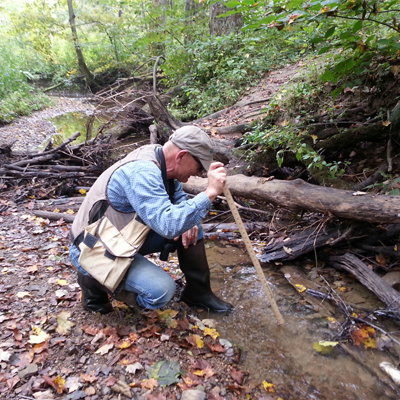
Top Notch Field Sites for Training Courses
Most of our courses involve training in the use of different assessment methods: QHEI, IBI, ICI, ORAM, VIBI, AmphIBI, HHEI, HMFEI or others. To best instruct in their use we visit aquatic resources that span the range of disturbance, from those that are highly disturbed from human activities to those that are minimally impacted which includes the best of what is present in Ohio. In that way the attendees get experience in gaging the resources they assess compared to the range of disturbance levels seen across the landscape.
As this year’s training schedule comes to an end I am reminded of the high quality of some of the wetlands and streams we visited during the field sessions of our courses. What a great opportunity it is to visit these intact ecosystems and observe with our course participants the standards against which all Ohio aquatic resources are measured. I find people really enjoy being at these high end sites and that the intensity of their observations for assessment is always elevated. More is expected of these rare and often preserved resources and seldom are we disappointed.
I remember visiting Calamus Swamp, a diverse kettle hole wetland near Circleville, where we saw swamp loosestrife, Decodon verticillatus, growing. I was happy to find this plant as there are few locations in central Ohio where it grows. Calamus Swamp is also home to a population of Ohio’s largest terrestrial salamander, the Tiger Salamander, Ambystoma tigrinum, as well as eight species of frogs and toads. Calamus Swamp has somewhat of a ring pattern of wetland plants communities with a forest community at the exterior, followed by a shrub community and then an emergent marsh community with areas of shrub islands at the interior. Some of the memorable plants encountered during our visit were Buttonbush, Cephalanthus occidentalis, River Bulrush, Schoenoplectus fluviatilis, Prickly Hornwort, Ceratophyllum echinatum, and Bulb Bearing Water Hemlock, Cicuta bulbifera. The diversity in the plant community, including most of the common aland plants found in central Ohio, made it an ideal venue for seeing a host of wetland species which was perfect for our Identification of Common Wetland Plants course. Surprisingly, Sweetflag or Calamus, Acorus calamus, the kettle hole’s namesake does not grow at the swamp. Apparently Giant Bur-reed, Sparganium eurycarpum, which is common at Calamus Swamp, was mistaken for Calamus by some of the kettle hole’s early visitors and the name has stuck through time.
We conducted our Primary Headwater Habitat course’s field sessions at Slate Run Metro Park using the headwater stream named, oddly enough, Slate Run. This primary headwater stream supports a large salamander population of predominately the Southern Two-lined Salamander, Eurycera cirrigera but also has a smaller population of Northern Dusky Salamander, Desmognathus fuscus. The macroinvertebrate community is also at the extreme high end of the spectrum with a taxa rich composition including Cranefly larvae, Water Penny beetles, EPT taxa (Caddisfly larvae and Mayfly and Stonefly nymphs) along with several species indicative of coldwater habitat. The fish species we collected through seining some of the pools included Mottled Sculpin, Cottus bairdii, Blacknose Dace, Rhinichthys atratulus, Southern Red-bellied Dace, Phoxinus erythrogaster, Central Stoneroller, Campostoma anomalum, Silverjaw Minnow, Notropis buccatus, Creek Chub, Semotilus atromaculatus, and Bluntnose Minnow, Pinephales notatus. The substrates are diverse both in size and composition and the water runs as clear as a glass of bottled drinking water. The results of our physical habitat and biological assessments assign this Slate Run to Class 3B, the highest quality classification for primary headwater streams. This outcome agreed with our observations as Slate Run is a truly beautiful stream.
We are lucky to have resources like Calamus Swamp and Slate Run to make trips to in central Ohio. The foresight and importance afforded to preservation by the Percy May family, Columbus Audubon, and Columbus and Franklin County Metro Parks have made this possible and they should be applauded. Thanks to their efforts we are able to visit intact, high quality resources and get a feel for what the Ohio landscape looked like centuries ago.
